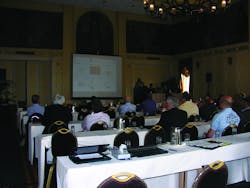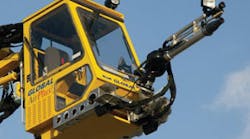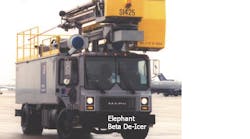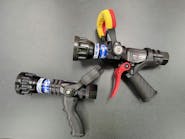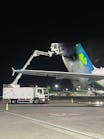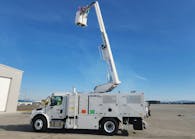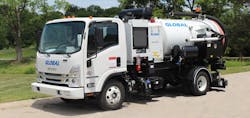SAE Deicing Committee Meets in San Francisco
Attendees — comprising of airlines, OEMs, suppliers and consulting firms — converged at Intercontinental Mark Hopkins from May 12-19 in San Francisco for the SAE Technical Committee G-12 Aircraft Ground Deicing meeting.
The SAE Technical Committee G-12 Aircraft Ground Deicing consists of eight subcommittees that address elements of equipment that include design, maintenance, operation and in-service experience.
The topics discussed included aircraft and runway deicing fluids, deicing facilities, and emerging equipment technology, among others. Here are some of the highlights of this year’s meeting.
G-12 Aircraft Deicing Fluids Committee
The committee’s meeting included an update from the European Aviation Safety Agency. Alberto Fernando Lopez of EASA discussed a recent study of deicing services at European airports.
The study was conducted by independent contractor, Airsight. Lopez explains that the study was aimed at investigating existing European national regulations, as well as examining the availability of fluids, costs associated with operations, and to provide recommendations.
The study began in April 2010 and included surveys sent to airlines, airports, deicers and authorities. The interim report included the results of the survey. In December 2010, there was a stakeholders committee, which included the survey respondents.
The final report was issued on May 2011 and is available on the EASA website. The contents include a cost model of deicing provisions, recommendations to EASA and an impact assessment of recommendations. The recommendations in the study included improved coordination with European authorities, the FAA and Transport Canada. Also, it recommended the collection of more safety data as it pertained to incidents.
G-12 Deicing Facilities Committee
The facilities committee meeting included an update from airports in North America and Europe concerning the 2010/2011 deicing season. Many reported record winter seasons.
Mike Grantz of IDS gave an overview of deicing operations at some of its locations, including Detroit, Milwaukee and MSP. “This was, by far, the busiest winter we have seen as a company,” he says. MSP recorded its fourth snowiest season, and closed for the first time in 19 years. At that location, IDS deiced about 9,400 flights over the season. In Detroit, it recorded 70 inches of snow and the company deiced more than 10,000 aircraft with its fleet of 19 trucks, with an average throughput of 45 aircraft during the heaviest times, according to Grantz.
Frankfurt Airport also experienced a record deicing season, Oliver Arzt of N*CE Aircraft Services says. For the 2010/2011 season, the company had a total budget of 5,001 aircraft deicings, which was based on a 10-year average. Overall, it performed 16,602 deicings — more than three times the anticipated number. Among the strategies that were put in place to cover the large volume include more stabilized feeding of aircraft to the deicing pad and improved availability of ADF. Arzt says new items in the 2010/2011 season included an Airport Collaborative Decision Making program to enhance communications. “There is a lot of coordination required to make the most of airport throughput,” he says.
Arzt says the company is in the initial talks to strengthen available infrastructure for future operations. The company will also expand its truck fleet from 42 vehicles to 51 going into the next season.
The facilities representatives also discussed deicing the A380. Ken Eastman of Servisair in Toronto says the company, which deiced more than 15,000 aircraft the past season, has deiced the A380 45 times, using six trucks on each operation. Arzt of N*CE Aircraft Services in Frankfurt says the company has deiced the superjumbo 55 times since it went into service. Mario Rosa of AeroMag 2000 said the company has begun deicing the superjumbo since it started service at YUL in 2010. To accommodate the aircraft, he says, the company has put a new procedure in place, which included modified safety zones for vehicles while aircraft are deiced.
Move to a CDF
During the meeting, Brett Patterson, director, airside operations, Vancouver Airport Authority, discussed the airport’s recent move to a centralized deicing facility. In the previous model, it had four deicing service providers for 37 carriers. There were three pads, and suppliers had 20 deicing trucks combined to provide services.
In 2008, the airport conducted a study of deicing operations to look at customer service, safety and efficiency. Through its analysis, the airport concluded that it would benefit from a common-use provider, as aircraft spent less time in queue. The final study recommendations stated that the airport should move to a common-use provider, construct a new deicing bay and add deicing trucks to its fleet. Through a two-phase approach that began in 2009, the airport licensed a single-service provider (AeroMag 2000), purchased trucks and installed necessary equipment, such as message sign boards. Today, there are 22 trucks total and the facility has a blending station, HD cameras and 13.5 million liters of effluent glycol storage capacity. In the 2010-2011 season, the facility deiced more than 2,000 aircraft. With a service delivery target of 80 percent, it has achieved 95.4 percent, which Patterson points to as a measure of the program’s success.
G-12 Equipment Committee
The equipment committee discussed several topics, including forced air technology and blending systems. However, one popular topic that emerged during presentations was telemetry systems for tanks and trucks, and the technology’s ability to accurately communicate fluid usage, improve safety and reduce costs.
Jeff Gaskill, managing director at LAS-USA, discussed the company’s battery-powered telemetry unit for glycol tanks. The system includes a level sensor installed in a tank, which is connected to the telemetry unit. The unit then reads levels periodically throughout the day and stores measurements with time and date stamps. Customers can access the recorded information via a customized website and specialized reports. “We can run a plethora of reports on your fluid consumption,” Gaskill explains.
Ed Sachs, deicer engineering manager at JBT AeroTech, gave an update on the company’s Tempest telemetry system, which performs automatic monitoring, alerting and record keeping of fluid usage. It also has the ability to remotely control proportional mix settings and send fluid-spray data directly to invoice databases. It can also be integrated into existing systems, he adds. “We focus on onboard value-added. We understand that most customers and users already have systems on the landside,” he says. “What we want to do is tie our information on fluid usages into your systems.”
Greg Myers of ForgeFX discussed the Management Information Database Accounting System (MIDAS), which is a performance tracking system for both trucks and operators. “Our goal was to track every bit of data so that operators, trucks, and eventually entire fleets could be managed and the data could reflect what they were doing,” he says. For operator performance tracking, the system offers an adjustable grading system and provides average service statistics for each operator. The system was designed in conjunction with Global Ground Support, but Myers notes that the system can be fitted to most other manufacturers’ equipment.
Anders Larson also gave an update on Vestergaard’s data transmission system, saying it is in use on about 150 units across Canada, United States and Europe. The web-based system communicates data (such as fluid usage and operation time) using a GSM/GPRS system. One of the recent additions to the system is the tracking of the temperature at the nozzle for each individual job, he notes.
